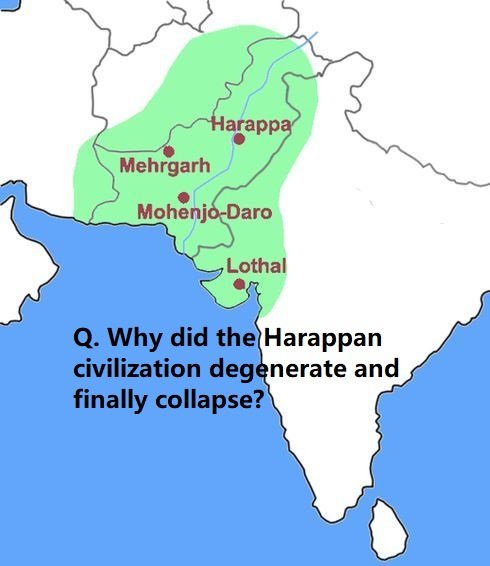The collapse of the Harappan civilization, also known as the Indus Valley Civilization, around 1900 BCE is attributed to a combination of factors rather than a single cause. Here are some key reasons suggested by historians and archaeologists:
Environmental Changes
- Climate Change: Evidence suggests significant climate change during the period, including a shift in monsoon patterns that led to drought conditions. This would have affected agriculture, leading to food shortages and the decline of urban centers.
- River Changes: The drying up of the Ghaggar-Hakra River, believed to be part of the Saraswati River system, and changes in the course of the Indus River could have disrupted the water supply essential for agriculture and daily life.
Economic Factors
- Trade Decline: The Harappan civilization engaged in extensive trade with Mesopotamia and other regions. A decline in trade, possibly due to changes in trade routes or political instability in trading partners, could have weakened the economy.
- Over-exploitation of Resources: There is evidence of deforestation and soil depletion, which may have led to a reduction in agricultural productivity and contributed to the economic decline.
Social and Political Factors
- Urban Decay: Excavations have shown signs of urban decline, such as poorly maintained infrastructure, indicating that the administrative and social systems were breaking down.
- Migration and Invasion: Some scholars suggest that invasions or migrations by Indo-Aryan groups may have contributed to the decline, though this theory is debated and lacks definitive archaeological evidence.
Internal Factors
- Decline in Trade and Craft Specialization: The standardized system of weights and measures and the uniformity in artifacts and city planning suggest a highly organized society. A decline in trade and craft specialization might have disrupted this organization.
- Health Issues: Evidence of malnutrition and diseases found in skeletal remains indicates declining health conditions, which could have reduced the population and labor force, further weakening the civilization.
Summary
The collapse of the Harappan civilization was likely due to a combination of environmental, economic, social, and political factors. The interplay of these factors would have gradually weakened the civilization, leading to the abandonment of cities and a shift to rural lifestyles.
Understanding the decline of the Harappan civilization remains an ongoing area of research, with new discoveries and theories continuing to emerge.


